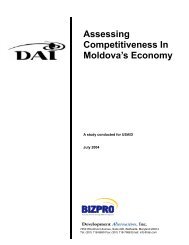Trade and Commercial Law Assessment - Honduras - Economic ...
Trade and Commercial Law Assessment - Honduras - Economic ...
Trade and Commercial Law Assessment - Honduras - Economic ...
Create successful ePaper yourself
Turn your PDF publications into a flip-book with our unique Google optimized e-Paper software.
TRADE AND COMMERCIAL LAW ASSESSMENT DECEMBER 2004<br />
HONDURAS<br />
XII.<br />
A.<br />
FLOW OF PEOPLE<br />
INTRODUCTION<br />
After Costa Rica, <strong>Honduras</strong> has the greatest flow of people across its borders in the region.<br />
Annua l visitors to the country numbered more than 886,000 in 2003, up from 672,000 in 2001,<br />
a<br />
32 percent<br />
rise. According to officials, a great number of these visitors (i.e., 276,000, or<br />
approximately<br />
one-third of travelers) are on single-day excursions from cruise ships. The<br />
greatest<br />
share of cross-border traffic (58 percent) comes from residents of other Central<br />
Americ an countries. North American visitors account for 30 percent of total visitors; Europeans,<br />
7 percent;<br />
<strong>and</strong> others, the remaining 5 percent.<br />
In total, arrival by air constitutes the largest portion of cross-border traffic, with<br />
<strong>Honduras</strong>’s two<br />
airports receiving roughly 44 percent of <strong>Honduras</strong>’s arrivals (29 percent arriving at San Pedro<br />
Sula<br />
<strong>and</strong> 20 percent arriving in Tegucigalpa), according to immigration agency sources.<br />
Approximately 34 percent of travelers cross the l<strong>and</strong> borders; 2 percent travel by sea. Among<br />
l<strong>and</strong> crossings, El Amatillo (El Salvador) <strong>and</strong> Guasule mark the major entry points, with 21<br />
percent each of crossings. Las Manos ranks third, with 15 percent of overall traffic. As noted<br />
previously, tourism is one of <strong>Honduras</strong>’s largest “exports” (the highest export after maquilas),<br />
<strong>and</strong> significant<br />
money flow results from the flow of people. Revenue from tourism provided<br />
$373 million<br />
in 2003, up from $274 million in 2001 (a 36 percent rise).<br />
Overall, Honduran laws <strong>and</strong> public <strong>and</strong> private institutions facilitate the flows of trade-related<br />
people. <strong>Honduras</strong> is streamlining processes at l<strong>and</strong> border crossings, upgrading its automation,<br />
<strong>and</strong> am ending its laws. However, as with other Honduran public institutions, Honduran peopleflow<br />
institutions are not professional <strong>and</strong> are overly politicized. Also, <strong>Honduras</strong> could do more to<br />
simplify<br />
its system for h<strong>and</strong>ling highly skilled visitors seeking longer stays. Work permits<br />
require more than 12 pieces of paperwork <strong>and</strong> involve five or more government agencies.<br />
Further, <strong>Honduras</strong> can do more to address illegitimate people flows, which remain a significant<br />
problem. <strong>Honduras</strong>’s borders with Guatemala, El Salvador, <strong>and</strong> Nicaragua are long <strong>and</strong> porous,<br />
<strong>and</strong> <strong>Honduras</strong> now serves as a key origin <strong>and</strong> transit country for illegal immigration to the United<br />
States.<br />
B. LEGAL FRAMEWORK<br />
The legal framework generally supports core trade facilitation intraregional movements of traderelated<br />
persons such as business travelers <strong>and</strong> transporters. There are no undue restrictions.<br />
However, the law presents a legal maze for highly skilled workers seeking longer stays.<br />
1. <strong>Law</strong>s <strong>and</strong> Regulations That Support <strong>Trade</strong> Facilitation<br />
<strong>Law</strong>s <strong>and</strong> regulations further trade facilitation through the following measures:<br />
♦ The law does not require a visa for visitors from the United States, the EU, Canada,<br />
Mexico, <strong>and</strong> the CAFTA countries.<br />
♦ With regard to regional harmonization, the CA-4 requirements provide a model in the<br />
immigration area. These new requirements allow CA-4 members to travel freely without<br />
XII-1

















